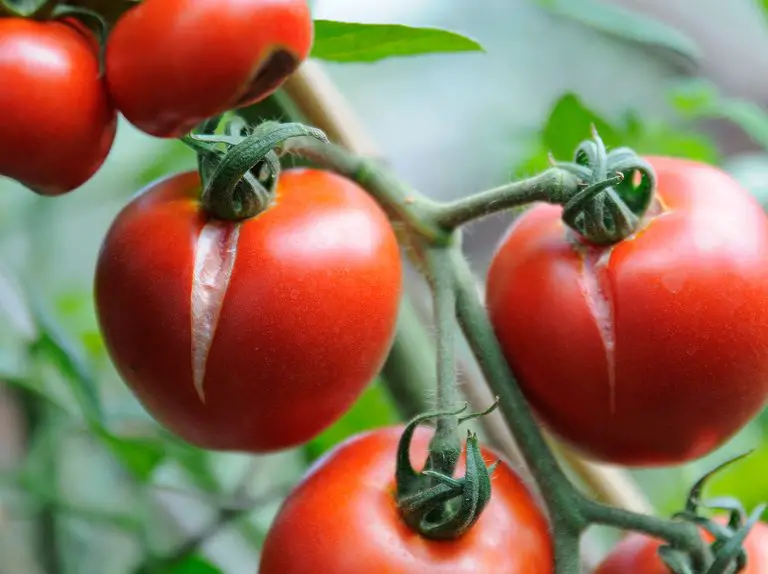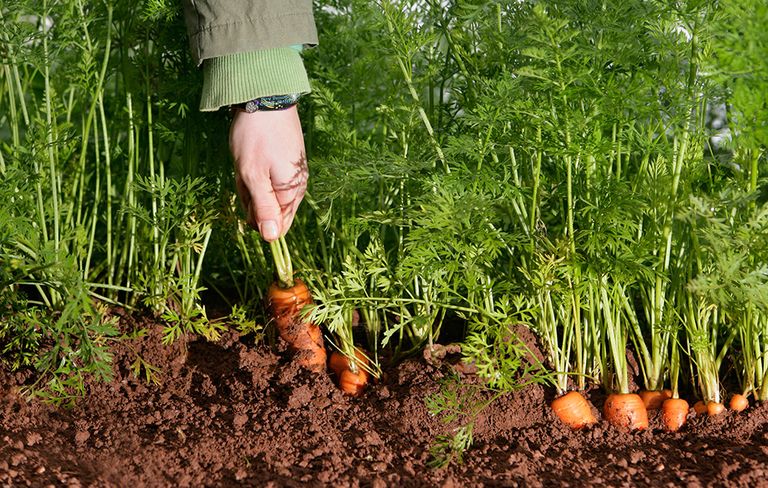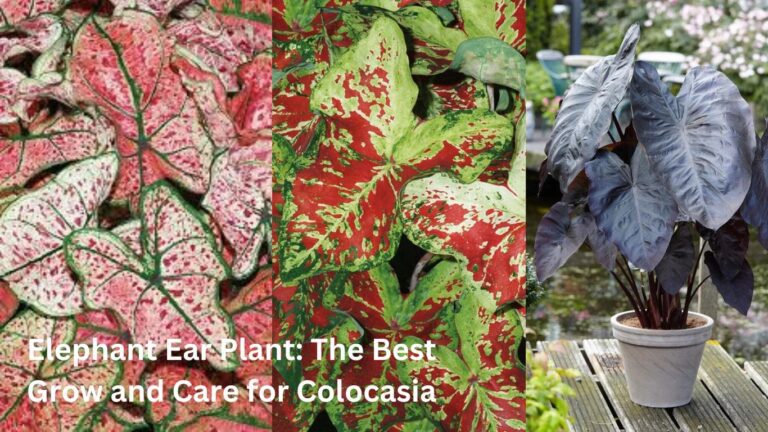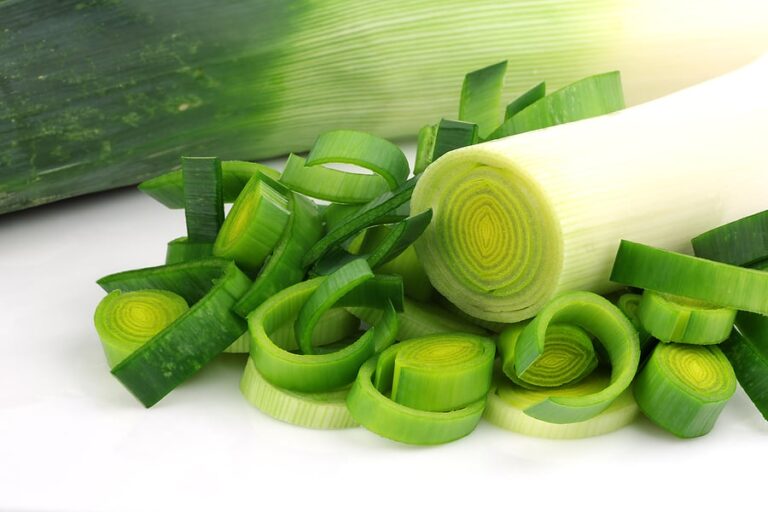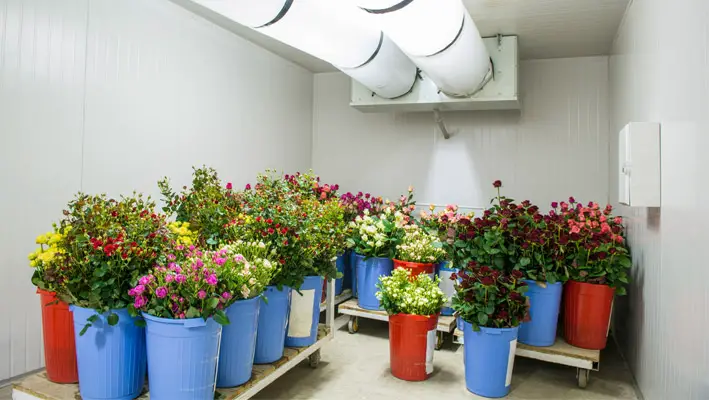Unraveling the Mystery of Tomato Splitting
Causes of Tomato Splitting
Tomato splitting is a common phenomenon that can be frustrating for gardeners. Understanding the causes of tomato splitting is crucial in order to prevent this issue and ensure a bountiful harvest. There are several factors that contribute to tomato splitting, including variations in moisture levels and inadequate soil conditions.
One of the main causes of tomato splitting is the fluctuation in moisture levels. If a tomato plant receives inconsistent watering, it can lead to uneven growth and development of the fruit. When the plant experiences a sudden increase in water availability, the cells in the fruit rapidly expand, causing the skin to crack. This is particularly prevalent in periods of heavy rainfall or sudden irrigation after a dry spell. Uneven watering practices can also lead to nutrient imbalances, which exacerbate the problem.
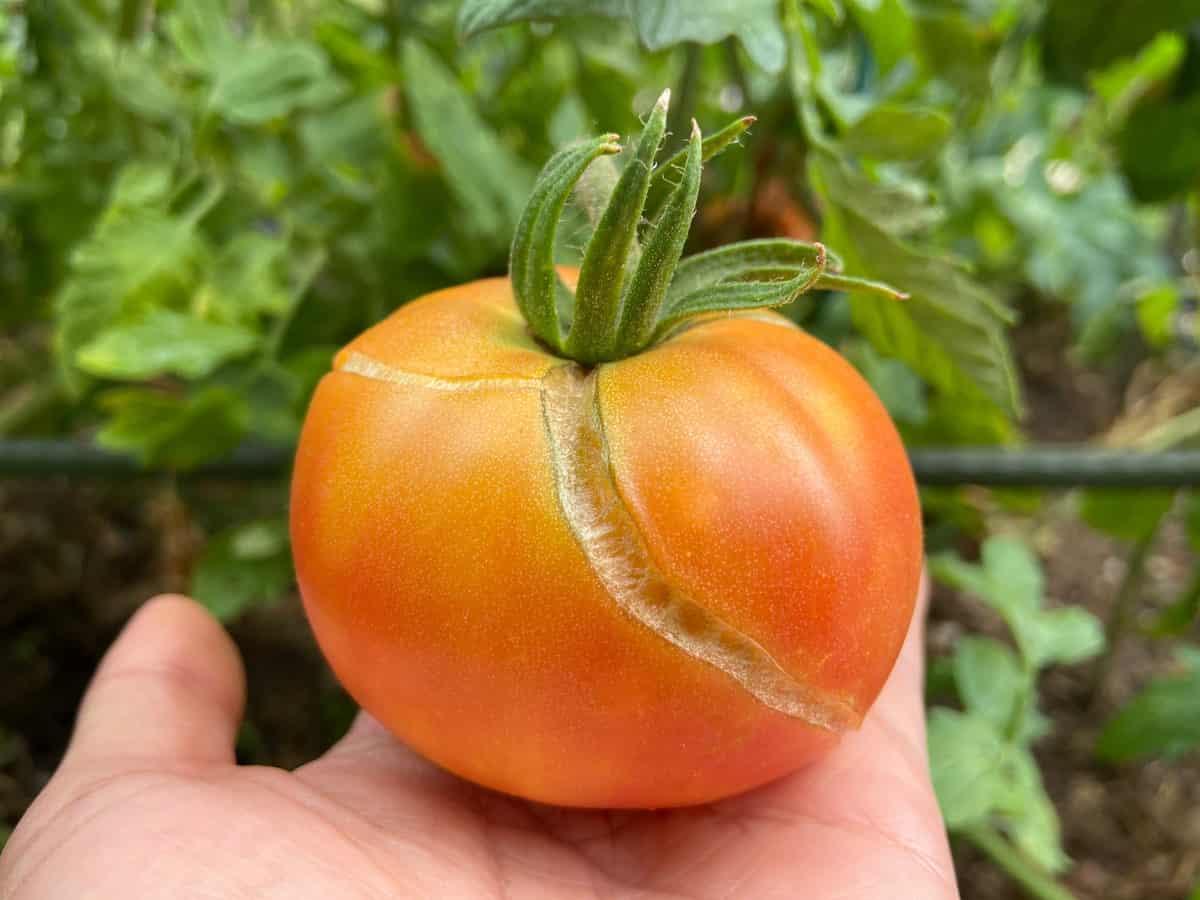
Another factor that can contribute to tomato splitting is inadequate soil conditions. The soil plays a crucial role in providing essential nutrients and moisture to the plants. If the soil lacks the necessary nutrients, the tomatoes may develop weak cell walls, making them more prone to splitting. Similarly, if the soil does not retain enough moisture or drains poorly, the tomatoes may experience moisture stress, resulting in splitting. It is important to ensure that the soil is rich in organic matter, well-drained, and properly fertilized to minimize the risk of tomato splitting.
Preventing Tomato Splitting
To prevent tomato splitting, it is crucial to ensure that the plants receive consistent and appropriate watering. Irregular watering, where plants go from dry to saturated soil, can lead to the expansion and contraction of the fruit, resulting in splitting. To maintain a consistent moisture level, consider using a drip irrigation system or watering deeply and less frequently rather than shallow, frequent watering.
Another key aspect of preventing tomato splitting is to provide adequate support for the plants. As the fruits develop and ripen, the weight can cause stress on the branches, leading to splitting. Using stakes, cages, or trellises to support the tomato plants will help distribute the weight evenly and reduce the risk of splitting. Additionally, pruning excess foliage can also help alleviate stress on the branches and minimize the occurrence of splitting.
By adopting these preventive measures, gardeners can significantly reduce the risk of tomato splitting and enjoy a bountiful harvest of intact, delicious tomatoes. Remember, providing consistent watering and proper support are crucial steps in maintaining the health and integrity of your tomato plants.
Understanding the Anatomy of a Tomato
Tomatoes, scientifically known as Solanum lycopersicum, are a popular fruit that is widely cultivated around the world. To truly understand the anatomy of a tomato, let’s delve into its various parts. The tomato plant consists of a main stem, leaves, flowers, and fruits. The leaves are responsible for photosynthesis, converting sunlight into energy essential for growth. They also serve as a protective shield, preventing excessive moisture loss.
As we focus on the fruit itself, we find that the tomato can be categorized into two distinct regions: the pulp and the skin. The pulp, also known as the pericarp, encases the seeds and is rich in nutrients such as vitamins A, C, and K, as well as antioxidants like lycopene. The skin, on the other hand, acts as a protective layer, guarding the fruit against external factors and reducing water loss through its cuticle.
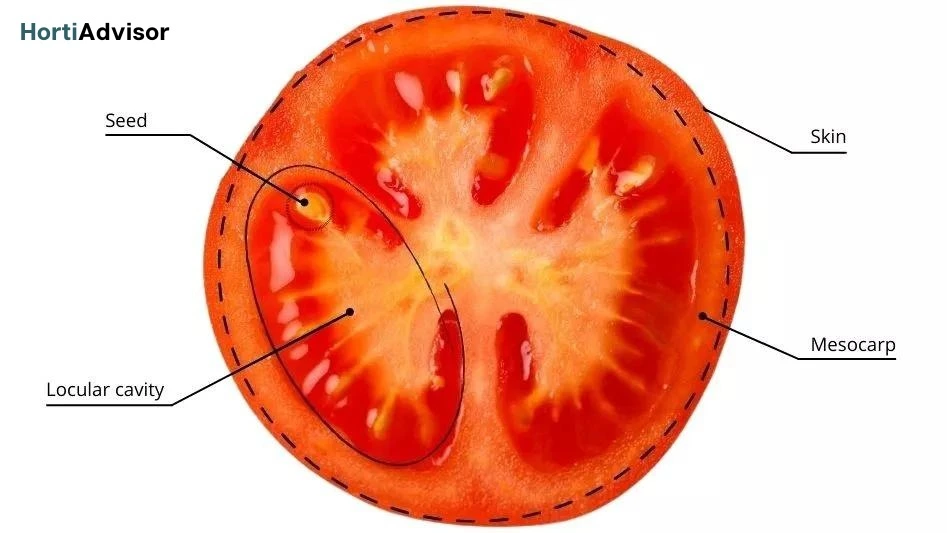
Within the tomato fruit, we also encounter the locular cavities, which are the spaces that house the seeds. These locules are divided by thin, gelatinous partitions called septa. The number of locules can vary depending on the type of tomato, with some having only two and others containing multiple locules. Another notable feature is the placenta, a spongy tissue that surrounds the seeds and aids in nutrient transfer.
Understanding the anatomy of a tomato is vital for comprehending its growth, as well as identifying potential issues that may arise. By examining this remarkable fruit’s internal structure, we can gain a deeper appreciation for the complexities that contribute to its development and overall quality.
The Role of Watering in Tomato Splitting
Watering plays a crucial role in the development and overall health of tomato plants. However, improper watering practices can lead to splitting in tomatoes, causing frustration for gardeners. Splitting occurs when there is a sudden influx of water, causing the tomato to expand quickly and the skin to burst.
To prevent tomato splitting due to watering, it is important to maintain a consistent watering schedule. Irregular watering, with periods of drought followed by heavy watering, can create stress for the tomato plant and increase the likelihood of splitting. It is recommended to water your tomato plants deeply and evenly, ensuring that the root zone receives adequate moisture. This can be achieved by watering at the base of the plant, avoiding overhead sprinklers that can lead to uneven distribution of water. Additionally, mulching around the base of the plants can help to retain moisture in the soil, reducing the impact of fluctuating water levels on the tomatoes. By understanding and implementing proper watering practices, gardeners can minimize the risk of tomato splitting and enjoy healthy, intact fruits.
Optimal Soil Conditions for Tomato Growth
Tomatoes are one of the most popular and widely cultivated plants in home gardens. To ensure optimal growth and successful production, it is essential to provide tomatoes with the right soil conditions. The right soil conditions not only promote healthy plant growth but also contribute to minimizing issues such as disease, nutrient deficiencies, and, in the case of this article, tomato splitting.
First and foremost, tomatoes thrive in well-draining soil. This is crucial as excessive moisture can lead to root rot and various diseases. Sandy loam soil is often recommended for tomato growth, as it allows excess water to drain away while retaining enough moisture for the plants. To enhance drainage, adding organic matter like compost or aged manure to the soil can be beneficial.
Additionally, tomatoes require a slightly acidic soil pH ranging from 6.0 to 6.8. Soil pH greatly impacts nutrient availability, and maintaining the appropriate acidity level ensures that essential nutrients are accessible to the plants. Conducting a soil test can help determine the current pH level and guide you in adjusting it accordingly using organic soil amendments or commercial products.
Moreover, tomatoes are heavy feeders, requiring a rich soil that is abundant in nutrients. Before planting, it is recommended to incorporate organic fertilizers or well-balanced slow-release fertilizers into the soil. These fertilizers will provide a steady supply of nutrients throughout the growing season, supporting healthy growth and development.
Here is a table that shows us the opy=timal soil conditions for tomato growth:
| Soil Condition | Importance | Recommendations |
|---|---|---|
| Drainage | Crucial for preventing root rot and diseases | – Sandy loam soil for optimal drainage |
| – Incorporate organic matter like compost or aged manure for enhanced drainage | ||
| pH Level | Impacts nutrient availability | – Maintain slightly acidic soil pH (6.0 to 6.8) |
| – Conduct a soil test to determine pH and adjust using organic amendments or products | ||
| Nutrient Content | Essential for healthy growth and development | – Use organic fertilizers or well-balanced slow-release fertilizers before planting |
| – Ensure a rich soil with an abundance of nutrients for continuous support throughout season | ||
| Moisture Retention | Balance between drainage and retaining moisture | – Choose sandy loam soil that provides balanced drainage and moisture retention |
| – Mulch around plants to help retain soil moisture | ||
| Soil Temperature | Warm soil promotes germination and vigorous growth | – Plant in soil with a temperature above 50°F (10°C) |
In conclusion, providing optimal soil conditions for tomato growth is crucial for achieving successful and bountiful harvests. Well-draining soil, slightly acidic pH, and nutrient-rich composition are key factors to consider when preparing the soil for tomato cultivation. By paying careful attention to these soil conditions, gardeners can set their tomato plants up for excellent growth and minimize the risk of tomato splitting.
The Impact of Temperature on Tomato Splitting
Tomatoes are highly sensitive to temperature fluctuations, which can greatly impact their overall health and development. One of the key factors that contribute to tomato splitting is extreme temperature changes. When temperatures fluctuate rapidly, the fruit expands and contracts, resulting in the skin cracking and splitting open.
High temperatures, especially during the ripening stage, can also lead to tomato splitting. The intense heat causes the fruits to ripen quickly, putting pressure on their skin. As a result, the skin cannot stretch enough to accommodate the rapid growth, leading to splits and cracks.
In contrast, sudden drops in temperature can also cause tomato splitting. When tomatoes experience a sudden shift from hot to cool conditions, they can undergo stress, which weakens the skin’s elasticity. This lack of flexibility makes the tomatoes more prone to splitting.
It is crucial for gardeners to monitor the temperature in their tomato growing environment and take the necessary precautions to prevent extreme temperature fluctuations. By maintaining a moderate and consistent temperature, gardeners can greatly reduce the risk of tomato splitting and ensure healthy, intact fruits.
Choosing the Right Tomato Variety to Minimize Splitting
When it comes to minimizing tomato splitting, choosing the right tomato variety can make a significant difference. Some tomato varieties are more prone to splitting than others, so selecting the right one can help prevent this issue from occurring in the first place.
One important factor to consider is the thickness and elasticity of the tomato’s skin. Varieties with thicker and more elastic skin tend to be less prone to splitting. For example, Roma tomatoes and Cherry tomatoes are known for their thicker skins, making them a good choice for gardeners looking to minimize splitting. On the other hand, larger beefsteak tomatoes often have thinner skins and are more susceptible to splitting.
Another factor to consider is the size of the tomato variety. Smaller tomato varieties, such as grape and cherry tomatoes, are less likely to split compared to larger varieties. This is because smaller tomatoes have a smaller volume of water content, reducing the likelihood of the fruit expanding and causing the skin to split.
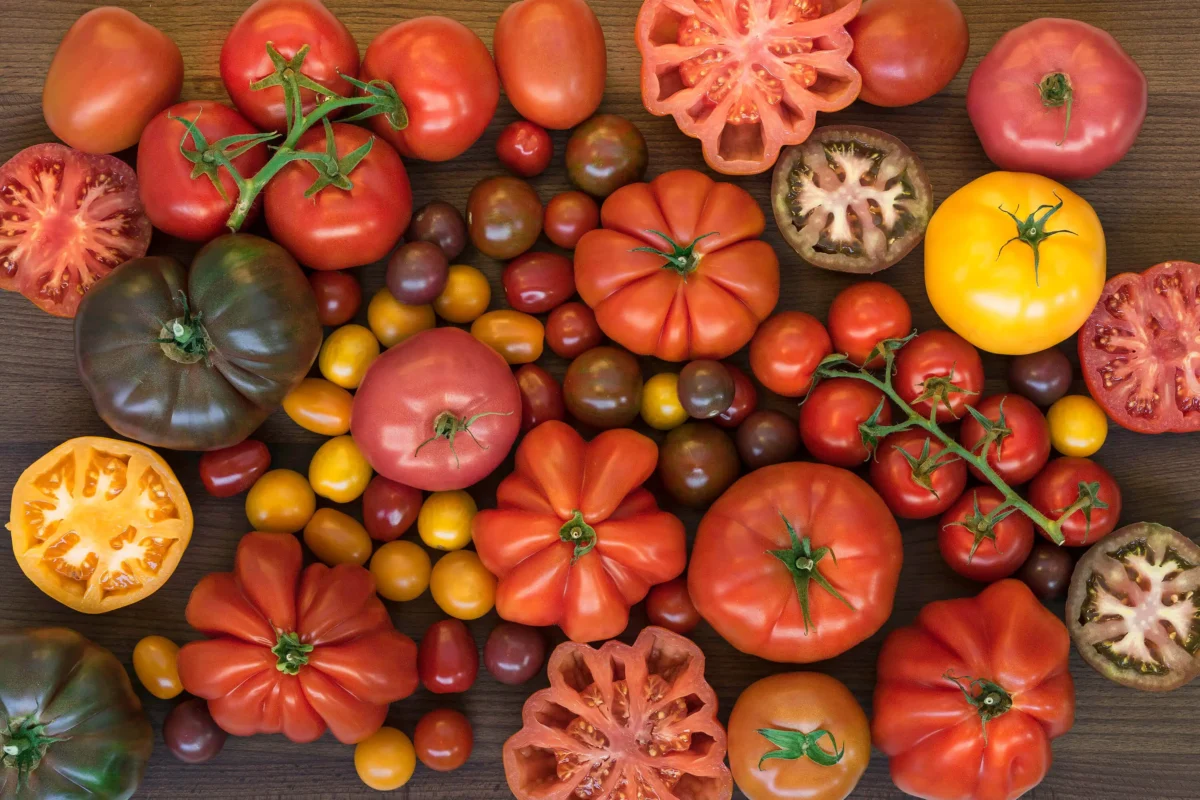
In addition to skin thickness and size, the maturity of the tomato variety can also play a role in splitting. Choosing varieties that mature quicker can help reduce the risk of splitting, as overripe tomatoes are more susceptible to this issue. Be sure to pay attention to the suggested maturity dates provided by the seed or plant supplier when selecting your tomato variety.
By carefully selecting tomato varieties with thicker skins, smaller sizes, and appropriate maturity dates, you can minimize the risk of splitting and enjoy a bountiful harvest of beautiful, intact tomatoes.
The Relationship between Tomato Splitting and Nutrient Imbalances
Tomato splitting is a common issue that many gardeners face, and one of the factors that can contribute to this problem is nutrient imbalances. Nutrients play a vital role in the healthy development of tomato plants, and an inadequate supply or an imbalance of these essential elements can result in fruit splitting.
Tomatoes require a balanced blend of nutrients, including nitrogen, phosphorus, potassium, calcium, and magnesium, among others, to grow and develop properly. When there is a deficiency or excess of any of these nutrients, the plant’s physiology can be affected, leading to various problems, including tomato splitting.
An imbalance of calcium, in particular, is often associated with tomato splitting. Calcium plays a crucial role in the development and integrity of cell walls, and a lack of calcium can weaken these structures, making the fruit more susceptible to splitting. On the other hand, too much calcium can also negatively impact tomato growth, leading to physiological disorders.
Maintaining the proper nutrient balance is essential to prevent tomato splitting. Conducting a soil test is a recommended practice to assess the nutrient levels and identify any deficiencies or imbalances. Based on the results, gardeners can then make informed decisions about the appropriate fertilizers or amendments to apply.
In addition to proper fertilization, ensuring a consistent and adequate water supply is crucial for nutrient uptake. Water acts as a medium for nutrient absorption and transportation within the plant. Inconsistent or insufficient watering can hinder the plant’s ability to take up essential nutrients, further exacerbating nutrient imbalances and increasing the risk of tomato splitting.
It is important to remember that nutrient imbalances cannot be corrected overnight. It may take some time and careful monitoring to achieve the proper nutrient balance for your tomato plants. Regular soil testing, keeping an eye on plant health, and making appropriate adjustments to fertilization and watering practices can help minimize the occurrence of tomato splitting associated with nutrient imbalances.
Identifying Early Signs of Tomato Splitting
Early signs of tomato splitting can often be detected by closely examining the fruit as it begins to develop. One of the first signs to look out for is the presence of small cracks or fissures near the stem end. These cracks may start out small and almost imperceptible, but they can gradually widen and deepen over time. Additionally, you may notice slight discoloration or blemishes on the skin of the tomato, indicating that the splitting process has already begun.
Another early sign of tomato splitting is the appearance of concentric rings or circles on the fruit’s surface. These rings, which may be lighter or darker in color than the surrounding skin, can indicate the formation of tension and stress within the tomato. As the internal pressure builds up, the fruit becomes more susceptible to splitting. Therefore, it is crucial to monitor the development of these rings and take appropriate measures to prevent further damage.
By keeping a close eye on these early signs of tomato splitting, gardeners can intervene at the right time and prevent extensive damage to their crops. Prompt identification of these signs is essential for implementing preventive measures effectively and ensuring the healthy growth of the tomatoes.
The table below shows the signs of tomato splitting:
| Early Signs of Tomato Splitting | Description | Identification Tips |
|---|---|---|
| Small Cracks or Splits | – Tiny fissures on the surface of the tomato skin | – Regularly inspect tomatoes as they begin to mature |
| – Observe for the presence of small cracks or splits | ||
| Concentric Rings or Radial Cracks | – Circular or radiating cracks around the stem end | – Examine the area where the stem connects to the tomato |
| – Look for rings or cracks spreading from this central point | ||
| Skin Distortion | – Uneven or distorted appearance of the tomato skin | – Check for irregularities in the shape and texture of the skin |
| – Notice any bulging or abnormalities on the tomato surface | ||
| Puffiness or Swelling | – The tomato may appear puffy or swollen in certain areas | – Gently squeeze the tomato to detect any soft or inflated areas |
| – Pay attention to changes in texture and overall firmness | ||
| Inconsistent Coloring | – Uneven coloration, especially near potential splitting areas | – Observe variations in color, particularly around the stem end |
| – Note any patches of discoloration that may indicate stress |
Best Practices for Pruning Tomato Plants
When it comes to tomato plants, pruning can be a valuable practice that helps promote healthy growth and maximize yield. However, it is essential to follow best practices to ensure that you don’t unintentionally harm your plants. One crucial tip for pruning tomato plants is to focus on removing the suckers. Suckers are the small shoots that emerge in the axils between the stem and the main branches. By removing these suckers, you can redirect the plant’s energy towards fruit production instead of excessive foliage growth.
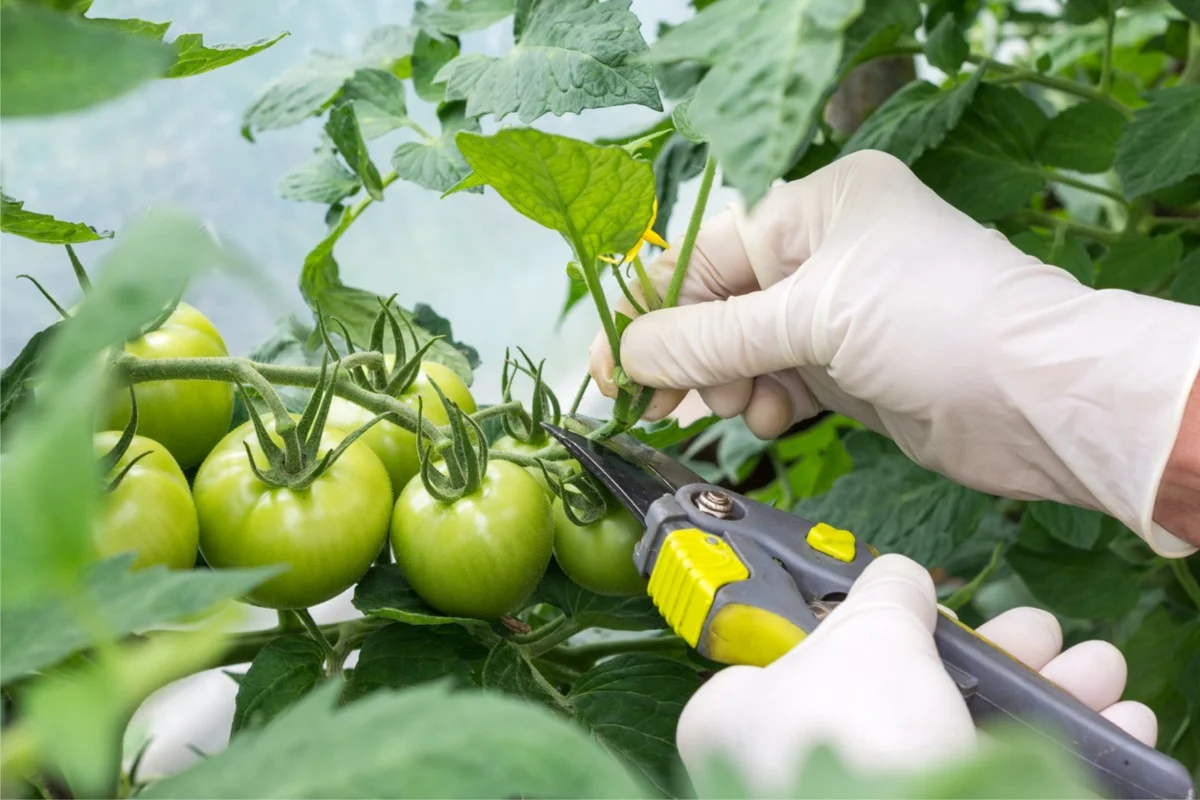
Another best practice for pruning tomato plants is to regularly remove any yellow or diseased leaves. These leaves can become a breeding ground for pests and diseases, affecting the overall health of your plants. By promptly removing them, you minimize the risk of a widespread infestation and promote better air circulation around the plant.
Remember, pruning tomato plants should be done with caution and precision. Over-pruning can lead to reduced fruit production, so it’s essential to strike a balance. By following these best practices, you can ensure that your tomato plants grow strong, healthy, and productive, providing you with a bountiful harvest.
The Role of Genetics in Tomato Splitting
Genetics plays a significant role in the occurrence of tomato splitting. The characteristics of a tomato plant, including its susceptibility to splitting, can be inherited through genetic factors. Research has shown that some tomato varieties are more prone to splitting than others due to their genetic makeup.
For instance, certain heirloom varieties tend to have thinner skin, making them more vulnerable to splitting. On the other hand, modern hybrid varieties have been specifically bred to have thicker skin, reducing the likelihood of splitting. This shows that genetic manipulation can help minimize the occurrence of tomato splitting.
Understanding the genetic factors that contribute to splitting can assist gardeners in selecting the right tomato varieties for their needs. By choosing varieties with genetic traits that promote thicker skin and reduce splitting risks, gardeners can effectively prevent this common issue. Consequently, genetics should not be overlooked when considering methods for preventing tomato splitting in your garden.
Common Mistakes to Avoid to Prevent Tomato Splitting
There are a few common mistakes that many gardeners make when trying to prevent tomato splitting. One mistake is overwatering the plants. While tomatoes need consistent watering, excessive moisture can actually lead to splitting. Overwatering causes the tomatoes to absorb more water than they can handle, resulting in the fruit expanding too quickly and causing the skin to crack. It is important to find the right balance and only water the plants when they truly need it.
Another mistake to avoid is inconsistent watering. Tomatoes prefer to be consistently moist, but not constantly wet. If the plants go through periods of drought followed by excessive watering, it can stress the tomatoes and make them more prone to splitting. It is essential to establish a regular watering schedule and monitor the soil moisture levels to ensure that the plants receive adequate hydration without being overwhelmed.
Taking these common mistakes into consideration and adjusting your approach to tomato care can greatly reduce the occurrence of splitting. By providing the right amount of water at the right time, you can help your tomatoes thrive and produce healthy, unblemished fruit.
How to Protect Tomatoes from Extreme Weather Conditions
Extreme weather conditions, such as severe storms, high winds, and hail, can wreak havoc on tomato plants. These adverse weather events can easily damage the delicate stems, leaves, and fruits of tomato plants, resulting in reduced yield and poor overall plant health. However, there are several strategies that gardening enthusiasts can employ to protect their cherished tomato plants from these extreme weather conditions.
One effective way to shield tomatoes from extreme weather conditions is by using protective covers or structures. These can include sturdy cages or trellises that provide support and stability to the plants, preventing them from being uprooted by strong winds. Additionally, using row covers or tunnels can safeguard the plants from hail and heavy rain, reducing the chances of physical damage. These protective measures act as a shield, creating a barrier between the plants and the destructive forces of nature.
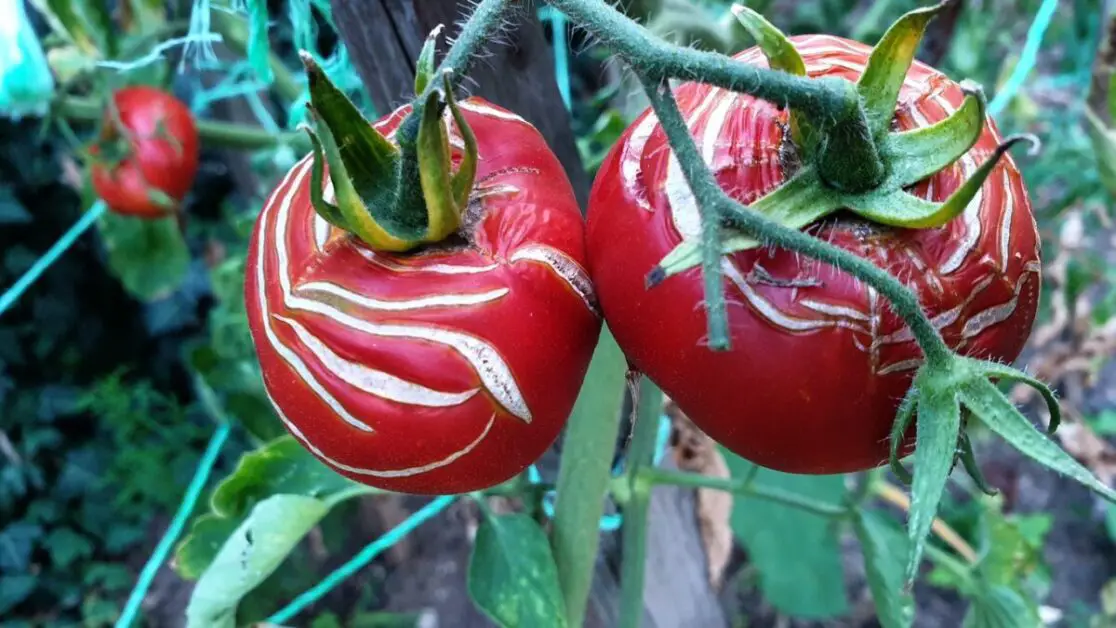
Another key aspect of protecting tomatoes from extreme weather conditions is proper watering. Adequate watering can help to strengthen the plants, making them more resilient to stress caused by extreme weather. It is crucial to water deeply and infrequently, allowing the roots to develop deep into the soil, providing stability and access to water during dry spells or high winds. Gardeners should also consider using mulch around the base of the plants to conserve moisture and regulate soil temperature, which can help to mitigate the impact of extreme weather events.
By employing these protective measures and implementing proper watering techniques, gardening enthusiasts can minimize the damage caused by extreme weather conditions and ensure the health and productivity of their tomato plants. However, it is important to remember that while these strategies provide valuable protection, some extreme weather events may still cause significant damage. In such cases, it is essential to assess the severity of the damage and take appropriate actions, such as pruning damaged areas or providing additional support to the plants, to aid in their recovery.
The Importance of Consistent Watering for Tomatoes
Consistent watering is a crucial factor in the successful cultivation of tomatoes. The water needs of tomato plants are specific and delicate, and any deviations can have significant consequences. Water plays a pivotal role in the overall growth and development of tomatoes, influencing everything from fruit formation to plant health.
When it comes to watering tomatoes, the key is to maintain consistent moisture levels in the soil. Tomatoes require a regular supply of water to support their rapid and continuous growth. Inconsistent watering can lead to various problems, including blossom end rot, fruit cracking, and wilting. These issues not only affect the quality and yield of the tomatoes but can also leave plants susceptible to diseases and pests.
Additionally, inconsistent watering can disrupt the delicate balance of nutrients within the plant. When water is scarce, essential nutrients may not be adequately absorbed and transported, leading to nutrient deficiencies. On the other hand, excessive watering can wash away crucial nutrients, depriving the plant of necessary sustenance. By ensuring consistent watering, you help maintain the optimal nutrient levels required for healthy tomato growth.
In conclusion, consistent watering is crucial for tomatoes as it directly affects their growth, fruit development, and overall plant health. By providing a consistent and appropriate water supply, you can safeguard your tomatoes from common issues such as fruit splitting and nutrient deficiencies. Stay tuned for upcoming sections in this article series, where we will explore other essential factors for successful tomato cultivation.
Understanding the Impact of Humidity on Tomato Splitting
Humidity plays a significant role in determining whether tomatoes split or not. When the humidity levels are high, the rate of evaporation decreases, causing the skin of the tomatoes to become more permeable. This makes them more susceptible to bursting due to the internal pressure generated by water absorption. Moreover, high humidity also reduces the transpiration rate of the plants, which affects the overall water balance and can lead to increased fruit splitting.
On the other hand, low humidity can also contribute to tomato splitting. When the air is dry, it can cause the tomatoes to lose moisture more rapidly, leading to dehydration of the fruit. This dehydration can result in a shriveled skin and increased fragility, making the tomatoes more likely to split when subjected to rapid changes in moisture levels, such as heavy rainfall or sudden irrigation.
It is important for tomato growers to monitor humidity levels and take appropriate measures to mitigate its impact on fruit splitting. Providing adequate ventilation in greenhouses or protecting outdoor plants with shade cloth can help moderate humidity levels. Additionally, maintaining consistent watering practices and using mulch around the base of the plants can also help regulate moisture levels and reduce the risk of tomato splitting. By understanding the impact of humidity on tomato splitting, gardeners can take proactive steps to create optimal growing conditions for their tomato plants and minimize fruit loss.
Watch this video to learn more about how to prevent tomato splitting.
Effective Strategies for Treating Split Tomatoes
Effective strategies for treating split tomatoes are vital to salvage the damaged fruit and prevent further deterioration. One method involves using a clean, sharp knife to remove the damaged portion of the tomato. It is important to make a clean, angled cut just below the split, ensuring there are no remnants of the split area. This method helps prevent the split from worsening and reduces the risk of rot or infection. After removing the damaged portion, it is crucial to store the tomato in a cool, dry place with good ventilation to allow it to heal and ripen further.
Another effective strategy is to make use of calcium supplements. Calcium deficiency in the plant can contribute to the splitting of tomatoes. By providing a calcium supplement through foliar sprays or by incorporating calcium-rich amendments into the soil, the plant can access the necessary nutrients and strengthen its cell walls, reducing the likelihood of tomato splitting. It is crucial to ensure the calcium supplement is applied as directed and in appropriate amounts to avoid interfering with other nutrient uptake or causing imbalances. Regular monitoring of calcium levels and adjusting the supplementation accordingly is essential for optimal plant health.
Implementing these strategies can help minimize the impact of tomato splitting and salvage a portion of the damaged fruit. However, prevention is always better than cure, and it is crucial to address the underlying causes to minimize the occurrence of tomato splitting in the first place. By following effective prevention methods, gardeners can ensure healthy, robust tomatoes free from splitting and enjoy the fruits of their labor to the fullest. In the following sections, we will delve into understanding the causes of tomato splitting and explore preventative measures to maintain the quality and yield of tomatoes.
What causes tomatoes to split?
Tomatoes can split due to various factors such as fluctuations in watering, temperature extremes, genetic predisposition, and nutrient imbalances.
How can I prevent tomato splitting?
To prevent tomato splitting, you can take measures such as providing consistent watering, avoiding overwatering, selecting appropriate tomato varieties, maintaining optimal soil conditions, and practicing proper pruning techniques.
How does watering affect tomato splitting?
Inconsistent watering, sudden increases in watering, or overwatering can lead to tomato splitting. It is important to provide regular and consistent watering to prevent this issue.
What are the optimal soil conditions for tomato growth?
Tomatoes thrive in well-draining soil with a pH level between 6.0 and 7.0. The soil should be rich in organic matter and provide essential nutrients like nitrogen, phosphorus, and potassium.
Does temperature impact tomato splitting?
Yes, extreme temperature fluctuations, particularly during the ripening stage, can cause tomatoes to split. Consistent and moderate temperatures are ideal for preventing this issue.
How can I choose the right tomato variety to minimize splitting?
Look for tomato varieties that are known for their resistance to splitting. Indeterminate varieties with thicker skins tend to be less prone to splitting compared to determinate varieties.
Can nutrient imbalances contribute to tomato splitting?
Yes, nutrient imbalances, particularly an excess of nitrogen, can lead to tomato splitting. It is important to maintain a balanced nutrient profile to avoid this issue.
What are the early signs of tomato splitting?
Early signs of tomato splitting include small cracks or fissures on the skin of the tomato, which can eventually lead to full splitting if not addressed.
How should I prune tomato plants to prevent splitting?
Proper pruning involves removing excessive foliage and side shoots to enhance airflow and sun exposure, which can help reduce the risk of tomato splitting.
Does genetics play a role in tomato splitting?
Yes, some tomato varieties are genetically more prone to splitting. Choosing varieties that have been bred for resistance to splitting can help minimize this issue.
What are common mistakes to avoid to prevent tomato splitting?
Common mistakes to avoid include overwatering, underwatering, inadequate soil nutrition, improper pruning techniques, and selecting unsuitable tomato varieties.
How can I protect tomatoes from extreme weather conditions?
To protect tomatoes from extreme weather, you can use various techniques such as providing shade, using row covers, mulching, and employing protective structures like greenhouses or cold frames.
Why is consistent watering important for tomatoes?
Consistent watering is important for tomatoes as it helps maintain even soil moisture levels, which reduces the risk of tomato splitting and promotes healthy fruit development.
What is the impact of humidity on tomato splitting?
High humidity levels can increase the likelihood of tomato splitting due to the absorption of excess moisture by the fruit. Adequate airflow and ventilation can help mitigate this issue.
What are effective strategies for treating split tomatoes?
Effective strategies for treating split tomatoes include harvesting split tomatoes immediately, using them for immediate consumption, and avoiding storing them for long periods as they may spoil faster.

